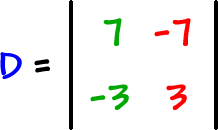I really think that Cramer's Rule is the easiest method for solving 2 x 2's. Especially if the answer is messy fractions (and it usually is)!
There's one little glitch...
Check this guy out:
![]()
![]()
 |
|
| Whatever |
|
and |
|
are, we'll be stuck with this: |

What does this mean? Well, we aren't going to get a nice (x, y) answer... In fact, we won't get ANY (x, y) answer! Either the lines are parallel or they are the same line. The only problem is that we can't tell. This is when you'll want to fall back on elimination to see which it is.
Which is it?